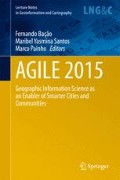Abstract
One important issue in developing assistive navigation systems for people with disability is the accuracy and relevancy of the systems’ knowledge bases from the perspective of these special user groups. The theory of affordances coupled with computer-based simulation offers a solution for automating the extraction of the relevant information from readily available sources—architectural floor plans. Simulation of movement in a wheelchair can be used to compute the accessible space of an indoor environment by comparing the degree of match between geometrical demands of navigation and the relevant physical properties of the environment. We also investigate what constitutes the right level of representation of the environment and adopt the grid graph model as suitable both for accessibility computation and for deriving higher-level networks of places and their connections that facilitate orientation and user-system interaction.
Access this chapter
Tax calculation will be finalised at checkout
Purchases are for personal use only
References
Afyouni, I., Ray, C., & Claramunt, C. (2010) A fine-grained context-dependent model for indoor spaces. In Proceedings of 2nd ACM SIGSPATIAL International Workshop on Indoor Spatial Awareness.
Afyouni, I., Ray, C., & Claramunt, C. (2012). Spatial models for context-aware indoor navigation systems: A survey. Journal of Spatial Information Science, 4, 85–123.
Barsalou, L. W. (1999). Perceptual symbol systems. Behavioral and Brain Sciences, 22, 577–660.
Barsalou, L. W. (2003). Situated simulation in the human conceptual system. Language and Cognitive Processes, 18(5/6), 513–562.
Budziszewski, P., Grabowski, A., Milanowicz, M., Jankowski, J., & Dzwiarek, M. (2011). Designing a workplace for workers with motion disability with computer simulation and virtual reality techniques. International Journal on Disability and Human Development, 10(4), 355–358.
Carneiro, T., Camara, G., de Andrade, P. R., & Pereira, R. R. (2011, February). An introduction to terrame. In INPE and UFOP Report, Version 1.5.
Chemero, A. (2003). An outline of a theory of affordances. Ecological Psychology, 15(2), 181–195.
Fallah, N., Apostolopoulos, I., Bekris, K., & Folmer, E. (2013). Indoor human navigation systems: A survey. Interacting with Computers, 25(1), 21–33.
Gibson, J. J. (1977). The theory of affordances. In R. Shaw & J. Bransford (Eds.), Perceiving (pp. 67–82)., Acting, and knowing: Toward an ecological psychology Hillsdale, NJ: Lawrence Erlbaum.
Höllerer, T., Hallaway, D., Tinna, N., & Feiner, S. (2001). Steps toward accommodating variable position tracking accuracy in a mobile augmented reality system. In AIMS’01: Second Int. Workshop on Artificial Intelligence in Mobile Systems (pp. 31–37), Seattle, WA, August 2001.
Jonietz, D., Schuster, W., & Timpf, S. (2013) Modelling the suitability of urban networks for pedestrians: An affordance-based framework. In D. Vandenbroucke et al. (Eds.). Geographic information science at the heart of Europe. Lecture Notes in Geoinformation and Cartography. Switzerland: Springer.
Jonietz, D., & Timpf, S. (2013) An affordance-based simulation framework for assessing spatial suitability. In T. Tenbrink et al. (Eds.), COSIT 2013. LNCS 8116 (pp. 169–184). Switzerland: Springer International Publishing.
Li, X., Claramunt, C., & Ray, C. (2010). A grid graph-based model for the analysis of 2d indoor spaces. Computers, Environment and Urban Systems, 34, 532–540.
Neufert, E. (2005). Bauentwurfslehre. Wiesbaden: Vieweg Verlag.
Ortmann, J., & Kuhn, W. (2010). Affordances as qualities. In Proceedings of the 2010 conference on Formal Ontology in Information Systems: Proceedings of the Sixth International Conference (FOIS 2010).
Raubal, M. (2001a). Agent-based simulation of human wayfinding: A perceptual model for unfamiliar buildings (Ph.D. Thesis, Vienna University of Technology).
Raubal, M. (2001b). Ontology and epistemology for agent-based wayfinding simulation. International Journal of Geographical Information Science, 15(7).
Raubal, M. (2008). Wayfinding: Affordances and agent simulation. In Encyclopedia of GIS.
Raubal, M., & Worboys, M. (1999). A formal model of the process of wayfinding in built environments. In C. Freksa, D. M. Marks (Eds.), COSIT’99. LNCS 1661 (pp. 381–399).
Richter, K.-F., Winter, S., & Santosa, S. (2011). Hierarchical representations of indoor spaces. Environment and Planning B: Planning and Design, 38(6), 1052–1070.
Rüetschi, U.-J., & Timpf, S. (2005). Modelling wayfinding in public transport: Network space and scene space. In C. Freksa et al. (Eds.), Spatial Cognition IV. LNAI 3343 (pp. 24–41). Heidelberg: Springer.
Scarantino, A. (2003). Affordances explained. Philosophy of Science, 70, 949–961.
Scheider, S. (2011). Grounding geographic information in perceptual operations (Ph.D. Thesis, Westfälische Wilhelms-Universität Münster).
Scheider, S., & Janowicz, K. (2014). Place reference systems. Applied Ontology, 9, 97–127.
Swobodzinski, M., & Raubal, M. (2008). An indoor routing algorithm for the blind: Development and comparison to a routing algorithm for the sighted. International Journal of Geographical Information Science, 00(00), 1–28.
Warren, W. H. (1984). Perceiving affordances: Visual guidance of stair climbing. Journal of Experimental Psychology, 10(5).
Acknowledgments
The work presented in this paper was conducted and financed as part of the LIFE project at the Institute for Geoinformatics (IFGI) of the University of Münster. The Universitäts- und Landesbibliothek were kind enough to provide floor plans for the library building. The authors owe gratitude to Dr. Pedro Ribeiro de Andrade of Brazil’s National Institute for Space (INPE) for his help with programming in the TerraME modelling environment, as well as Dr. Marco Painho of the NOVA School of Statistics and Information Management (ISEGI-NOVA) and Dr. Rui Li of IFGI for their valuable input.
Author information
Authors and Affiliations
Corresponding author
Editor information
Editors and Affiliations
Rights and permissions
Copyright information
© 2015 Springer International Publishing Switzerland
About this chapter
Cite this chapter
Kostic, N., Scheider, S. (2015). Automated Generation of Indoor Accessibility Information for Mobility-Impaired Individuals. In: Bacao, F., Santos, M., Painho, M. (eds) AGILE 2015. Lecture Notes in Geoinformation and Cartography. Springer, Cham. https://doi.org/10.1007/978-3-319-16787-9_14
Download citation
DOI: https://doi.org/10.1007/978-3-319-16787-9_14
Published:
Publisher Name: Springer, Cham
Print ISBN: 978-3-319-16786-2
Online ISBN: 978-3-319-16787-9
eBook Packages: Earth and Environmental ScienceEarth and Environmental Science (R0)

